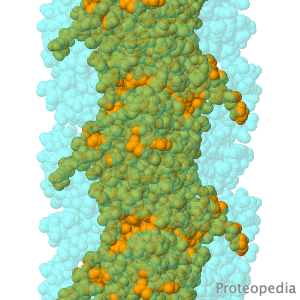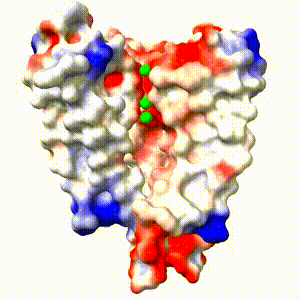Sandbox Home
From Proteopedia
(New page: <table id="tableColumnsMainPage" style="width:100%; border:2px solid #ddd; border-collapse:collapse; table-layout:fixed;"> <tr> <td colspan="3" style="background:#F5F5FC; border:1px ...) |
|||
| (18 intermediate revisions not shown.) | |||
| Line 1: | Line 1: | ||
| - | <table id="tableColumnsMainPage" style="width:100%; border:2px solid #ddd; border-collapse:collapse; table-layout:fixed;"> | + | <!-- Flexbox wrapper for logo and introductory text --> |
| + | <div style="display: flex; align-items: flex-start; margin-bottom: 1em;"> | ||
| + | <div style="margin-right: 20px;"> | ||
| + | <!-- Proteopedia Logo image/tag, e.g.: --> | ||
| + | <img src="ProteopediaLogo.png" alt="Proteopedia logo" style="height:80px;"> | ||
| + | </div> | ||
| + | <div> | ||
| + | <span style="border:none; margin:0; padding:0.3em; color:#000; font-style: italic; font-size: 1.4em;"> | ||
| + | <b>As life is more than 2D</b>, Proteopedia helps to bridge the gap between 3D structure & function of biomacromolecules | ||
| + | </span> | ||
| + | <br> | ||
| + | <span style="border:none; margin:0; padding:0.3em; color:#000; font-style: italic; font-size: 1.1em; max-width:80%; display:block;"> | ||
| + | <b>Proteopedia</b> presents this information in a user-friendly way as a '''collaborative & free 3D-encyclopedia of proteins & other biomolecules.''' | ||
| + | </span> | ||
| + | </div> | ||
| + | </div> | ||
| + | |||
| + | <table id="tableColumnsMainPage" style="width:100%;border:2px solid #ddd;border-collapse:collapse;table-layout:fixed;"> | ||
<tr> | <tr> | ||
| - | <td colspan="3" style="background:#F5F5FC; border:1px solid #ddd;"> | + | <td colspan="3" style="background:#F5F5FC;border:1px solid #ddd;vertical-align:top;"> |
| - | <div style=" | + | <div style="top:.2em;font-size:1.2em;padding:5px 5px 5px 10px;float:right;"> |
| - | + | '''''ISSN 2310-6301''''' | |
| - | + | </div> | |
| - | + | ||
| - | + | ||
| - | + | ||
| - | + | ||
| - | + | ||
| - | + | ||
</td> | </td> | ||
</tr> | </tr> | ||
| Line 26: | Line 37: | ||
</tr> | </tr> | ||
| - | <tr style="font-size:1.2em; text-align:center;"> | + | <tr style="font-size:1.2em;text-align:center;"> |
<td style="padding:10px; background-color:#33ff7b;"></td> | <td style="padding:10px; background-color:#33ff7b;"></td> | ||
<td style="padding:10px; background-color:#f1b840;"></td> | <td style="padding:10px; background-color:#f1b840;"></td> | ||
| Line 32: | Line 43: | ||
</tr> | </tr> | ||
| - | <tr style="font-size: | + | <tr style="font-size:1em;text-align:center;"> |
<td style="padding:10px;"> | <td style="padding:10px;"> | ||
<p>[[Help:Contents#For_authors:_contributing_content|How to add content to Proteopedia]]</p> | <p>[[Help:Contents#For_authors:_contributing_content|How to add content to Proteopedia]]</p> | ||
| Line 38: | Line 49: | ||
<p>[[Who knows]] ...</p> | <p>[[Who knows]] ...</p> | ||
</td> | </td> | ||
| - | |||
<td style="padding:10px;"> | <td style="padding:10px;"> | ||
<p>[[I3DC|About Interactive 3D Complements - '''I3DCs''']]</p> | <p>[[I3DC|About Interactive 3D Complements - '''I3DCs''']]</p> | ||
| Line 44: | Line 54: | ||
<p>[[How to get an I3DC for your paper]]</p> | <p>[[How to get an I3DC for your paper]]</p> | ||
</td> | </td> | ||
| - | |||
<td style="padding:10px;"> | <td style="padding:10px;"> | ||
<p>[[Teaching strategies using Proteopedia]]</p> | <p>[[Teaching strategies using Proteopedia]]</p> | ||
Current revision
<img src="ProteopediaLogo.png" alt="Proteopedia logo" style="height:80px;">
As life is more than 2D, Proteopedia helps to bridge the gap between 3D structure & function of biomacromolecules
Proteopedia presents this information in a user-friendly way as a collaborative & free 3D-encyclopedia of proteins & other biomolecules.
ISSN 2310-6301 |
||||||||
| Selected Research Pages | In Journals | Education | ||||||
|---|---|---|---|---|---|---|---|---|
|
|
|
||||||
|
How to add content to Proteopedia Who knows ... |
Teaching strategies using Proteopedia |
|||||||
|
||||||||



